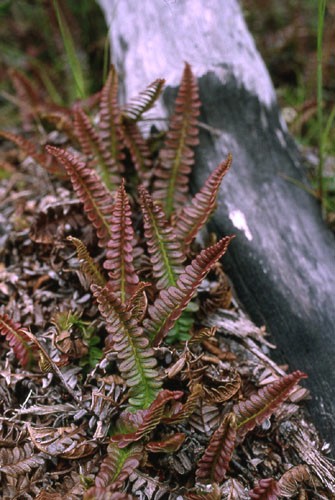|
Hardy Fern Home B. penna-marina resources
All Ferns � Blechnaceae �� Blechnum
�Other Genera
|
| Blechnum penna-marina | ||
Little hard fern, dwarf hard fern, alpine water fern | ||
|
Etymology
The name means Sea pen. Most Sea pens bear little resemblance to any fern, but this one does.
Description
Rhizome: short-creeping, branching.
Frond: 20 cm high by 2 cm wide, evergreen sterile fronds, dimorphic, fertile leaves appearing later, more erect than sterile, blade/stipe ratio: 3:1 in the sterile fronds but the stipe is longer in fertile fronds. Stipe: reddish brown at base, becoming straw-colored upwards, scales bullate, linear to ovate, reddish-brown, vascular bundles: at least 3 vascular bundles arranged in arc. Blade: 1-pinnate, linear-ovate, leathery, glossy, dark green in maturity, young fronds are often red, blade glabrous, rachis, costa, a few scales below. Pinnae: 12 to 25 pair, to 1 cm, fertile very narrow, 2 mm, curving upwards, sterile narrow, 5 mm, basal pinnae shorter, rounder; costae rachis and costae straw-colored, scales on lower surface small, sparse, brown; margins entire; veins sterile:free, often forked; fertile: veins of fertile leaves united to form sorus-bearing secondary vein parallel to costa or costule. Sori: elongate, continuous, on both sides of the costae, indusium: flap-like, opening towards the costa. Culture
Habitat: moist, acidic, alpine grasslands.
Distribution: Argentina, Chile, New Zealand, southeastern Australia.
Hardy to -25�C, USDA Zone 5.
Synonyms
Polypodium penna-marina Poir. Lomaria antarctica Carm. |
|
|
